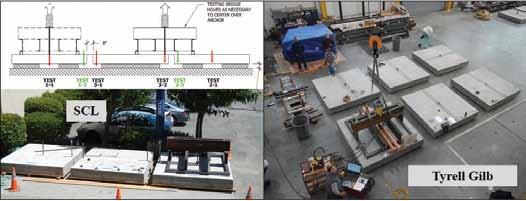
13 minute read
Structural Testing
issues and advances related to structural testing
Figure 1: Test layouts at SCL and Tyrell Gilb laboratories.
Starting in 2008, members of the project team, along with others, performed tests to show that the American Concrete Institute (ACI) 318-11 Appendix D concrete shear capacities for steel anchor bolts with small edge distances connected to wood sill plates were extremely low compared to actual tested values. As a result of the tests, a code change was Testing Tension-Only Steel made to the International Building Code (IBC) 2009 Anchor Rods Embedded in to allow the use of much Reinforced Concrete Slabs higher shear values for anchor bolts connected to wood sill plates. That project comprised a twoBy W. Andrew Fennell, P.E., CPEng, year effort driven by practicing engineers in
SECB, association with an industry partner. Gary L. Mochizuki, P.E., S.E., The current project is again aimed at provid-
LEED AP, ing practical test results to design professionals Kevin S. Moore, P.E., S.E., SECB, and building code officials, but this time for the Steven E. Pryor, P.E., S.E. and Geoffrey A. Laurin frequently specified (but not necessarily accepted) anchorage details in tension-only anchor rod systems. With the support of our industry partner (Simpson Strong-Tie® Company, Inc.), this project is moving closer to converting valuable test data into a useful design methodology and possible regulation modification. The current project is divided into two phases as follows: Phase 1 (completed in June 2012) proposed a testing protocol for the extensive Phase 2 testing. To validate and/or refine the proposed testing protocol, Phase 1 concluded with the construction and testing of three full-scale experimental specimens featuring both center-of-slab and edge-of-slab details. Phase 1 experiments were performed at Scientific Construction Laboratories, Inc. (SCL) in Lafayette, California (Figure 1). Phase 2 is currently in progress at Simpson Strong-Tie’s Tyrell Gilb Research Laboratory in Stockton, California (Figure 1). Phase 2 features full-scale podium slab sections with varying levels
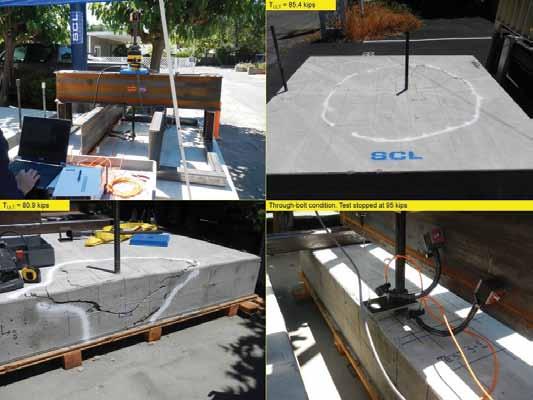
of special detailing for both center-of-slab and edge-of-slab conditions. Interim results suggest that test data correlates well with calculated uncracked average ultimate capacities of anchors (without anchor reinforcing) using ACI 318-11 Appendix D with all design reductions removed.
Testing Protocol Development
The research team selected the use of a monotonic loading protocol in an effort to understand controlling behaviors and failure mechanisms, and to establish data that is comparable to a majority of test data already available. Results of a literature search indicated that adding plates at the bottom of the embedded tension-only anchor rods would increase the size of the concrete failure cone, and hence the load capacity. The research team did not find any literature on reinforced concrete sections. Phase 1 experiments at SCL validated the testing protocol using a high-capacity testing bridge previously developed by Simpson Strong-Tie. Figure 1 depicts each 8-foot x 8-foot x 1-foot concrete specimen with anchors cast in the field and at the edge. The slabs were elevated off the ground to avoid any potential restraining effect on slab bending. Slabs were reinforced to prevent bending
Model Building Likely Rod System 3 story over podium @ edge San Francisco 3/4" Rod ASTM F 1554 Fu=58 ksi Nominal Tensile Strength
Break-out Capacities ACI-318-11 App. D Tested 19.2 kips ±10 kips Need 1.2 x 19.2k TBD
4 story over podium @ edge Seattle
1" Rod ASTM F 1554 Fu=75 ksi 44.2 kips ±10 kips Need 1.2 x 44.2k
5 story over podium @ edge Los Angeles Test 3-2. Edge Lafayette
Test 2-1. Center Lafayette
1-1/4" Rod ASTM A193 B7 HS Fu=125 ksi 115.0 kips Nuc,m = 70.3 kips Nc,5% = 42.2 kips Design = 22.2 kips
1-1/4" Rod ASTM A193 B7 HS Fu=125 ksi 1-1/4" Rod ASTM A193 B7 HS Fu=125 ksi 115.0 kips ±10 kips Need 1.2 x 115k
115.0 kips Nuc,m = 34.0 kips Nc,5% = 20.4 kips Design = 10.7 kips
*Note: Test 3-2 (embed at edge) had some reinforcement in the breakout zone. TBD
TBD
80.9 kips*
85.4 kips
failure per ACI 318-11, section D.3.3.2. To ensure that a bending failure would not occur, the amount of steel specified for the test was 75 percent more than the amount required by analysis. The slab was analyzed using RISA-3D as a compilation of plate elements, with the testing bridge as an assembly of beam elements.
ADVERTISEMENT–For Advertiser Information, visit www.STRUCTUREmag.org Figure 2 and Table 1 show a summary of the Phase 1 experiments. A published testing report describes further details related to the setup and results. Table 1 compares some model building design demands with currently available design capacities. The limited design capacity for concrete anchorage is immediately apparent once building height exceeds three stories. continued on next page
JEC Group brings the worldwide composites industry to Atlanta in a new mega event.
Discover the full global composites value chain from materials producers to end-users. See every final application sector, from design to mass production. Expand your business horizons, meet new partners, learn about the latest in composites innovations. Techtextil North America and Texprocess Americas join the JEC Group to bring this 3-in-1 international event to American composites stakeholders.

Georgia World Congress Center: May 13•14• 15• 2014
www.JECcompositesamericas-exhibitor.com
In all respects, Phase 1 experiments verified basic assumptions valuable to the development of the Phase 2 test program. Adequate reinforcing steel prevented bending failures in the slabs. The tension breakout cone failures for the center (away from edge) tests occurred as anticipated; however, the capacity was higher than expected. It appears that the flexural steel crossing through the cone added to its capacity. The tension breakout failure at the edge occurred at a load substantially higher than the ACI 318-11 Appendix D prediction. This was likely due to the unintentional benefit of vertically oriented hooks at the ends of the top and bottom flexural bars that crossed the cone failure plane in several locations. To understand the connection behavior more thoroughly, future tests (Phase 2) would include additional steel specifically to reinforce the cone (anchor reinforcing) located near the anchor and crossing the anticipated failure planes, as well as control tests without any anchor reinforcing.
Lessons Learned
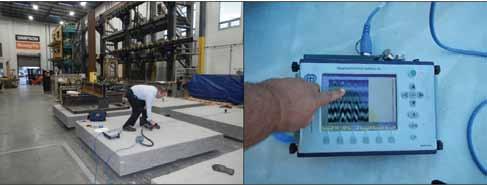
Figure 3: Non-destructive testing (NDT).
Figure 4: Cross-section of slab showing one-piece anchor reinforcement.
Large, high-strength anchor rods, nuts, washers and couplers are all potentially special-order items (not available at local construction supply centers), with significant lead times exceeding four days. To avoid substitution requests, consider providing enhanced submittal requirements in specifications for anchorage in design. Engineers are constantly receiving feedback and/or criticism from contractors regarding constructability. The Phase 1 experiments were no exception. The “as-planned” geometry for the anchor rods was difficult to achieve, particularly at edge conditions. Appropriately scaled sketches are necessary to verify the constructability of the anchorage connection. Non-destructive testing (NDT) techniques were employed as part of the Phase 1 effort. This testing was used to confirm as-built
236
Structural Design Spreadsheets
www.Engineering-International.com
• Three, Two, and One Story Comparison of Seismic and Wind Based on 2012 IBC / 2013 CBC.
• 4E-SMF with Wood Nailer Design
Based on AISC 358-10 & NDS 2012.
• Seismic Bi-axial Moment Frame
Design Based on AISC 358-10 & ACI 318-11.
Figure 5: Cross-section of slab showing two-piece anchor reinforcement.
clearances and/or geometry. NDT was limited to pachometers and ground-penetrating radar (GPR) methods (Figure 3). Based on NDT results, the research team confirmed that Structural Observation and/ or Special Inspection prior to concrete placement will provide good conformance with designed anchorage detailing. To ensure consistent construction quality, engineers might consider requiring and/or incorporating photo-documentation of installed anchorage and reinforcing around the anchor. While unique, this level of inspection and confirmation is important given the critical nature of most anchorages of this type.
Phase 2 Testing
The Phase 2 testing at Tyrell Gilb Research Laboratory involved 12 test specimens to research anchorage away from edges (i.e., field). These tests were designed to examine different conditions associated with various flexural reinforcement ratios, as well as the effect of localized anchor reinforcement. Future testing will be performed with anchors located at the edge of slabs to determine the effects of anchorage reinforcement at the slab edges. All specimens had a concrete compressive strength of 5,000 psi and reinforcing steel per ASTM A615, Grade 60. The 8-foot x 8-foot x 1-foot slabs were tested while supported off the ground by use of a grid of 4x4 timber members aligned with the test frame located at the top of the slab above. A hollow-core hydraulic ram applied displacement-controlled loads to the anchor. A representative from Testing Engineers Inc. independently observed and documented all Phase 2 experiments. The initial Phase 2 experiments were run in pairs to test three main configurations: (1) anchors without additional anchor reinforcement; (2) anchors with one-piece inclined anchor reinforcement (Figure 4); and (3) anchors with two-piece inclined anchor reinforcement (Figure 5). For each of these continued on page 56


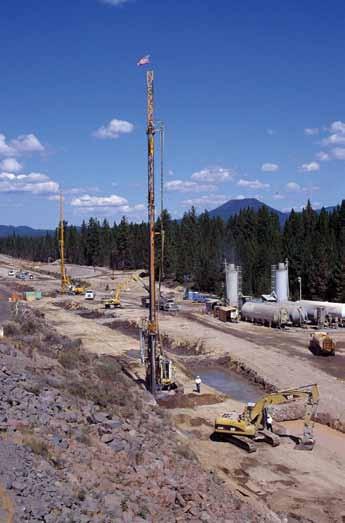
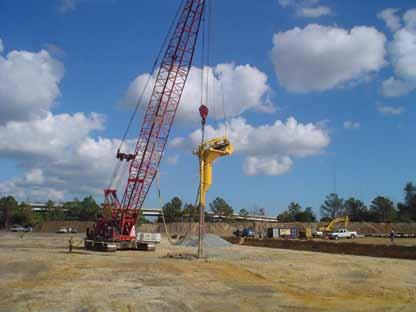
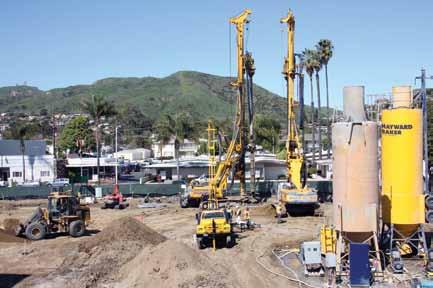
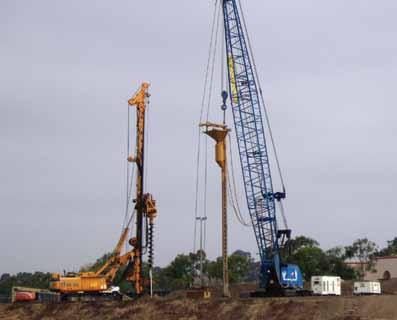
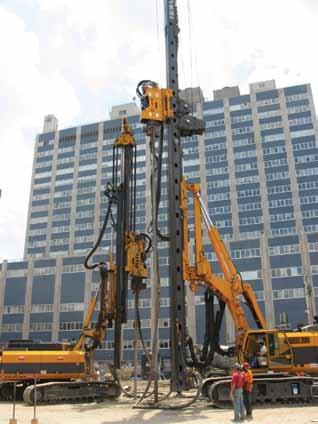
Table 2: Initial Phase 2 testing.
See
Figure 6
A
B
C
D
E
F
Simpson Upper Mat HS Anchor Anchor Peak Load Test ID Flexural Dia. (in) Reinforcing (kips) U666 A Inadequate 1.5 No 74 U666 B Inadequate 1.5 No 63 U665 A Adequate 1.5 No 110 U665 B Adequate 1.5 No 91 U668 A Inadequate 1.75 Yes. 1-piece 135 U668 B Inadequate 1.75 Yes. 1-piece 135 U942 A Inadequate 1.75 Yes. 2-piece 155 U942 B Inadequate 1.75 Yes. 2-piece 148 U667 A Adequate 1.75 Yes. 1-piece 197 U667 B Adequate 1.75 Yes. 1-piece 194 U941 A Adequate 1.75 Yes. 2-piece 223 U941 B Adequate 1.75 Yes. 2-piece 237 Figure 6: Initial Phase 2 test results. Pre-test photos courtesy of Testing Engineers, Inc. (TEI).
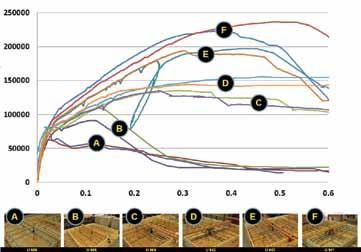
configurations, two slab flexural reinforcement conditions were varied. In the first case, flexural reinforcement was insufficient to prevent plastic hinging (Inadequate). In the second case, flexural reinforcement was sufficient to prevent plastic hinging (Adequate). As shown in Table 2 and Figure 6, Phase 2 results indicate that under-reinforced concrete slabs will typically fail in flexure before a shear cone can develop. These results prove the adequacy of ACI 318-11 Appendix D considering a limitation on anchor capacity for locations where a plastic hinge can form as noted in D.3.3.2. Figure 7 shows failure surfaces and corresponding peak loads (average of two tests) for two different anchor reinforcement conditions. Test B has no supplemental anchor reinforcement; Test E has a one-piece inclined bar anchor reinforcement. Figure 8 also shows the failure cone and corresponding peak loads (average of two tests) for reinforced and unreinforced anchor specimens. Test B has no supplemental anchor reinforcement; Test F has two-piece anchor reinforcement. With sufficient flexural reinforcement, a shear cone will develop as indicated in ACI 318-11 Appendix D. By adding anchorage reinforcement (bars dedicated to resist shear cone failure), the capacity of the anchor in tension can be significantly increased. ACI 318-11 section D.5.2.9 permits the strength of properly developed anchor reinforcing to be used in lieu of the tension cone breakout strength in determining design resistance. It is clear from the results of Tests “B” and “D” that neglecting the strength of the concrete breakout would be a highly conservative assumption for the tested condition. Test D was identical to Test B except for the addition of single-piece anchor reinforcing (Figure 4) that crossed the theoretical plane of the tension cone at a 45° angle. Cone failures controlled both test series, with the Test D cone projecting through the sloping sides of the anchor reinforcing. It is interesting that, in these sloping sides, the vertical component of the nominal yield strength was 105 kips. Figure 7 shows that the ultimate capacity of Test D is nearly the sum of this 105 kips and the Test B results. Predicting the average uncracked ultimate tension cone breakout force of Test B using ACI 318-11 equation (D-6) with kc=40 (instead of 24; this removes reductions for cracks and reduction from average result to 5% fractile), and also properly considering the ANC /ANCO ratio in accordance with D.5.2.1 and D.5.2.8, yields a predicted strength of 83 kips. Combined with the 105 kips from the anchor reinforcing results in a predicted sum of 188 kips, which is also very close to the 195-kip average test result. As mentioned previously, it is thought that the horizontal flexural reinforcing that passes through the breakout cone increases cone capacity, but the effect remains undetermined. When attempting to correlate test data and calculations for tension cone breakout strength,
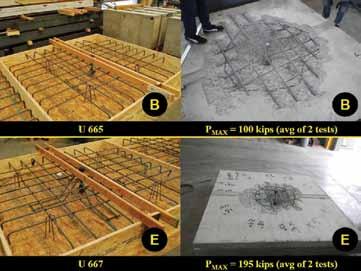
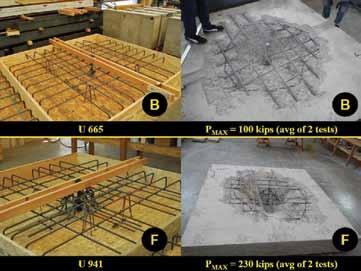
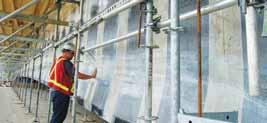
it was necessary not only to adjust the calculation to reflect the average instead of a 5 percent fractile result, but also to disregard the crack reduction factor even though bi-directional cracks through the cone were clearly evident during the testing and prior to cone failure, which should result in a larger crack reduction than just one-directional cracking. The inability of cracked concrete to transfer tensile stress across the crack in the cone area changes the internal force distribution in the cone, resulting in a smaller breakout force; yet it is also known that the amount of reinforcing in cracked concrete testing can significantly influence the result. More research is needed to understand how the crack reduction factor should be applied in concrete with significant flexural reinforcing passing through the cone. Developing anchor reinforcement on each side of the failure plane can further increase tension capacity. Different arrangements of shear reinforcement can shift the failure plane of the shear cone farther away from the anchor, increasing the area of the cone and the tension capacity of the anchor. Interim results suggest that some change to existing regulations may be warranted when considering this specific condition (anchor reinforcing in “thin” reinforced elements). Other groups (e.g. NEHRP Provisions Update Committee, Issue Team 3, and Simpson Strong-Tie) are further exploring this effort analytically and experimentally.▪ The Structural Engineers Association of Northern California (SEAONC) provided a $10,000 grant through their 2012 Special Projects Initiative. In the Phase 1 experiments, the Simpson Strong-Tie Company (SSTC) generously loaned their loading bridge and helped guide the protocol development. In the Phase 2 testing, Simpson Strong-Tie did virtually everything, from procuring the materials and constructing the specimens to leading the complex analysis of the data. This article is adapted from the Proceedings of the 10 th U.S. National Conference on Earthquake Engineering, which will take place July 21-25, 2014 in Anchorage, Alaska, hosted by the Earthquake Engineering Research Institute (EERI).
This article is derived from an Interim Report on Testing of Tension-Only Steel Anchor Rods Embedded in Reinforced Concrete Slabs, SEAOC Convention Proceedings, September 2013, San Diego, CA.
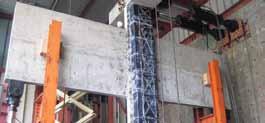
W. Andrew Fennell, P.E., CPEng, SECB (andy.sclabs@earthlink.net), is a Principal Engineer at Scientific Construction Laboratories, Inc., in Lafayette, California. Gary L. Mochizuki, P.E., S.E., LEED AP (gary@structsol.com), is a Principal Engineer at Structural Solutions, Inc., in Walnut Creek, California. Kevin S. Moore, P.E., S.E., SECB (ksmoore@sgh.com), is a Principal at Simpson, Gumpertz and Heger in San Francisco, California. Steven E. Pryor, P.E., S.E. (spryor@strongtie.com), is the International Director of Building Systems at Simpson Strong-Tie® Company, Inc., in Pleasanton, California. Geoffrey A. Laurin (laurincons@gmail.com), is a General Contractor and Principal at Laurin Consulting, LLC, in El Dorado, California.










